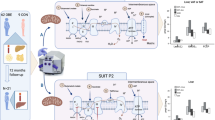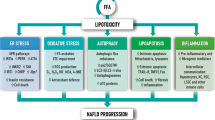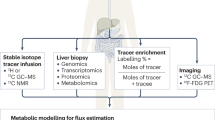Abstract
Background/Objectives:
Glycerol represents an important metabolite for the control of lipid accumulation and hepatic gluconeogenesis. We investigated whether hepatic expression and functionality of aquaporin-9 (AQP9), a channel mediating glycerol influx into hepatocytes, is impaired in non-alcoholic fatty liver disease (NAFLD) and steatohepatitis (NASH) in the context of insulin resistance.
Subjects/Methods:
Liver biopsies were obtained from 66 morbid obese patients undergoing bariatric surgery (66% women, mean body mass index (BMI) 46.1±1.0 kg m−2) with available liver echography and pathology analysis of the biopsies in this cross-sectional study. Subjects were classified according to normoglycemia (NG), impaired glucose tolerance (IGT) or type 2 diabetes (T2D). Hepatic expression of AQP9 was analyzed by real-time PCR, western blotting and immunohistochemistry, while glycerol permeability (Pgly) was measured by stopped-flow light scattering.
Results:
AQP9 was the most abundantly (P<0.0001) expressed aquaglyceroporin in human liver (AQP9>>>AQP3>AQP7>AQP10). Obese patients with T2D showed increased plasma glycerol as well as lower Pgly and hepatic AQP9 expression. The prevalence of NAFLD and NASH in T2D patients was 100 and 65%, respectively. Interestingly, AQP9 expression was decreased in patients with NAFLD and NASH as compared with those without hepatosteatosis, in direct relation to the degree of steatosis and lobular inflammation, being further reduced in insulin-resistant individuals. The association of AQP9 with insulin sensitivity was independent of BMI and age. Consistent with these data, fasting insulin and C-reactive protein contributed independently to 33.1% of the hepatic AQP9 mRNA expression variance after controlling for the effects of age and BMI.
Conclusions:
AQP9 downregulation together with the subsequent reduction in hepatic glycerol permeability in insulin-resistant states emerges as a compensatory mechanism whereby the liver counteracts further triacylglycerol accumulation within its parenchyma as well as reduces hepatic gluconeogenesis in patients with NAFLD.
This is a preview of subscription content, access via your institution
Access options
Subscribe to this journal
Receive 12 print issues and online access
$259.00 per year
only $21.58 per issue
Buy this article
- Purchase on Springer Link
- Instant access to full article PDF
Prices may be subject to local taxes which are calculated during checkout



Similar content being viewed by others
References
Chalasani N, Younossi Z, Lavine JE, Diehl AM, Brunt EM, Cusi K et al. The diagnosis and management of non-alcoholic fatty liver disease: practice Guideline by the American Association for the Study of Liver Diseases, American College of Gastroenterology, and the American Gastroenterological Association. Hepatology 2012; 55: 2005–2023.
Utzschneider KM, Kahn SE . Review: the role of insulin resistance in nonalcoholic fatty liver disease. J Clin Endocrinol Metab 2006; 91: 4753–4761.
Roden M . Mechanisms of disease: hepatic steatosis in type 2 diabetes—pathogenesis and clinical relevance. Nat Clin Pract Endocrinol Metab 2006; 2: 335–348.
Machado M, Marques-Vidal P, Cortez-Pinto H . Hepatic histology in obese patients undergoing bariatric surgery. J Hepatol 2006; 45: 600–606.
Boza C, Riquelme A, Ibanez L, Duarte I, Norero E, Viviani P et al. Predictors of nonalcoholic steatohepatitis (NASH) in obese patients undergoing gastric bypass. Obes Surg 2005; 15: 1148–1153.
Reshef L, Olswang Y, Cassuto H, Blum B, Croniger CM, Kalhan SC et al. Glyceroneogenesis and the triglyceride/fatty acid cycle. J Biol Chem 2003; 278: 30413–30416.
Frühbeck G . Obesity: aquaporin enters the picture. Nature 2005; 438: 436–437.
Frühbeck G, Catalán V, Gómez-Ambrosi J, Rodríguez A . Aquaporin-7 and glycerol permeability as novel obesity drug-target pathways. Trends Pharmacol Sci 2006; 27: 345–347.
Rodríguez A, Catalán V, Gómez-Ambrosi J, Frühbeck G . Aquaglyceroporins serve as metabolic gateways in adiposity and insulin resistance control. Cell Cycle 2011; 10: 1548–1556.
Jelen S, Wacker S, Aponte-Santamaria C, Skott M, Rojek A, Johanson U et al. Aquaporin-9 protein is the primary route of hepatocyte glycerol uptake for glycerol gluconeogenesis in mice. J Biol Chem 2011; 286: 44319–44325.
Calamita G, Gena P, Ferri D, Rosito A, Rojek A, Nielsen S et al. Biophysical assessment of aquaporin-9 as principal facilitative pathway in mouse liver import of glucogenetic glycerol. Biol Cell 2012; 104: 342–351.
Gena P, Mastrodonato M, Portincasa P, Fanelli E, Mentino D, Rodríguez A et al. Liver glycerol permeability and aquaporin-9 are dysregulated in a murine model of non-alcoholic Fatty liver disease. PLoS One 2013; 8: e78139.
Rojek AM, Skowronski MT, Fuchtbauer EM, Fuchtbauer AC, Fenton RA, Agre P et al. Defective glycerol metabolism in aquaporin 9 (AQP9) knockout mice. Proc Natl Acad Sci USA 2007; 104: 3609–3614.
Kuriyama H, Shimomura I, Kishida K, Kondo H, Furuyama N, Nishizawa H et al. Coordinated regulation of fat-specific and liver-specific glycerol channels, aquaporin adipose and aquaporin 9. Diabetes 2002; 51: 2915–2921.
Carbrey JM, Gorelick-Feldman DA, Kozono D, Praetorius J, Nielsen S, Agre P . Aquaglyceroporin AQP9: solute permeation and metabolic control of expression in liver. Proc Natl Acad Sci USA 2003; 100: 2945–2950.
Rodríguez A, Catalán V, Gómez-Ambrosi J, García-Navarro S, Rotellar F, Valentí V et al. Insulin- and leptin-mediated control of aquaglyceroporins in human adipocytes and hepatocytes is mediated via the PI3K/Akt/mTOR signaling cascade. J Clin Endocrinol Metab 2011; 96: E586–E597.
Catalán V, Gómez-Ambrosi J, Pastor C, Rotellar F, Silva C, Rodríguez A et al. Influence of morbid obesity and insulin resistance on gene expression levels of AQP7 in visceral adipose tissue and AQP9 in liver. Obes Surg 2008; 18: 695–701.
Miranda M, Ceperuelo-Mallafré V, Lecube A, Hernández C, Chacón MR, Fort JM et al. Gene expression of paired abdominal adipose AQP7 and liver AQP9 in patients with morbid obesity: relationship with glucose abnormalities. Metabolism 2009; 58: 1762–1768.
Genuth S, Alberti KG, Bennett P, Buse J, Defronzo R, Kahn R et al. Follow-up report on the diagnosis of diabetes mellitus. Diabetes Care 2003; 26: 3160–3167.
Brunt EM . Nonalcoholic steatohepatitis. Semin Liver Dis 2004; 24: 3–20.
Younossi ZM, Stepanova M, Rafiq N, Makhlouf H, Younoszai Z, Agrawal R et al. Pathologic criteria for nonalcoholic steatohepatitis: interprotocol agreement and ability to predict liver-related mortality. Hepatology 2011; 53: 1874–1882.
Bell LN, Wang J, Muralidharan S, Chalasani S, Fullenkamp AM, Wilson LA et al. Relationship between adipose tissue insulin resistance and liver histology in nonalcoholic steatohepatitis: a pioglitazone versus vitamin E versus placebo for the treatment of nondiabetic patients with nonalcoholic steatohepatitis trial follow-up study. Hepatology 2012; 56: 1311–1318.
Asai M, Higuchi S, Kubota M, Iguchi K, Usui S, Hirano K . Regulators for blood glucose level affect gene expression of aquaporin 3. Biol Pharm Bull 2006; 29: 991–996.
Tsukaguchi H, Weremowicz S, Morton CC, Hediger MA . Functional and molecular characterization of the human neutral solute channel aquaporin-9. Am J Physiol 1999; 277: F685–F696.
Rodríguez A, Catalán V, Gómez-Ambrosi J, Frühbeck G . Role of aquaporin-7 in the pathophysiological control of fat accumulation in mice. FEBS Lett 2006; 580: 4771–4776.
Frühbeck G, Gómez-Ambrosi J, Salvador J . Leptin-induced lipolysis opposes the tonic inhibition of endogenous adenosine in white adipocytes. FASEB J 2001; 15: 333–340.
Ishibashi K, Sasaki S, Saito F, Ikeuchi T, Marumo F . Structure and chromosomal localization of a human water channel (AQP3) gene. Genomics 1995; 27: 352–354.
Ishibashi K, Kuwahara M, Gu Y, Tanaka Y, Marumo F, Sasaki S . Cloning and functional expression of a new aquaporin (AQP9) abundantly expressed in the peripheral leukocytes permeable to water and urea, but not to glycerol. Biochem Biophys Res Commun 1998; 244: 268–274.
Elkjaer M, Vajda Z, Nejsum LN, Kwon T, Jensen UB, Amiry-Moghaddam M et al. Immunolocalization of AQP9 in liver, epididymis, testis, spleen, and brain. Biochem Biophys Res Commun 2000; 276: 1118–1128.
Nicchia GP, Frigeri A, Nico B, Ribatti D, Svelto M . Tissue distribution and membrane localization of aquaporin-9 water channel: evidence for sex-linked differences in liver. J Histochem Cytochem 2001; 49: 1547–1556.
Rojek A, Fuchtbauer EM, Fuchtbauer A, Jelen S, Malmendal A, Fenton RA et al. Liver-specific aquaporin 11 knockout mice show rapid vacuolization of the rough endoplasmic reticulum in periportal hepatocytes after feeding amino acids. Am J Physiol Gastrointest Liver Physiol 2013; 304: G501–G515.
Lebeck J, Gena P, O'Neill H, Skowronski MT, Lund S, Calamita G et al. Estrogen prevents increased hepatic aquaporin-9 expression and glycerol uptake during starvation. Am J Physiol Gastrointest Liver Physiol 2011; 302: G365–G374.
Branes MC, Morales B, Rios M, Villalon MJ . Regulation of the immunoexpression of aquaporin 9 by ovarian hormones in the rat oviductal epithelium. Am J Physiol Cell Physiol 2005; 288: C1048–C1057.
Wellejus A, Jensen HE, Loft S, Jonassen TE . Expression of aquaporin 9 in rat liver and efferent ducts of the male reproductive system after neonatal diethylstilbestrol exposure. J Histochem Cytochem 2008; 56: 425–432.
Pastor-Soler NM, Fisher JS, Sharpe R, Hill E, Van Hoek A, Brown D et al. Aquaporin 9 expression in the developing rat epididymis is modulated by steroid hormones. Reproduction 2010; 139: 613–621.
Ji YF, Chen LY, Xu KH, Yao JF, Shi YF, Shanguan XJ . Reduced expression of aquaporin 9 in tubal ectopic pregnancy. J Mol Histol 2013; 44: 167–173.
Calamita G, Portincasa P . Present and future therapeutic strategies in non-alcoholic fatty liver disease. Expert Opin Ther Targets 2007; 11: 1231–1249.
Widhalm K, Ghods E . Nonalcoholic fatty liver disease: a challenge for pediatricians. Int J Obes (Lond) 2010; 34: 1451–1467.
Postic C, Girard J . The role of the lipogenic pathway in the development of hepatic steatosis. Diabetes Metab 2008; 34: 643–648.
Calamita G, Ferri D, Gena P, Carreras FI, Liquori GE, Portincasa P et al. Altered expression and distribution of aquaporin-9 in the liver of rat with obstructive extrahepatic cholestasis. Am J Physiol Gastrointest Liver Physiol 2008; 295: G682–G690.
Potter JJ, Koteish A, Hamilton J, Liu X, Liu K, Agre P et al. Effects of acetaldehyde on hepatocyte glycerol uptake and cell size: implication of aquaporin 9. Alcohol Clin Exp Res 2011; 35: 939–945.
Portincasa P, Calamita G . Water channel proteins in bile formation and flow in health and disease: when immiscible becomes miscible. Mol Aspects Med 2012; 33: 651–664.
Potter JJ, Koteish A, Hamilton J, Liu X, Liu K, Agre P et al. Effects of acetaldehyde on hepatocyte glycerol uptake and cell size: implication of aquaporin 9. Alcohol Clin Exp Res 2011; 35: 939–945.
Lehmann GL, Carreras FI, Soria LR, Gradilone SA, Marinelli RA . LPS induces the TNF-alpha-mediated downregulation of rat liver aquaporin-8: role in sepsis-associated cholestasis. Am J Physiol Gastrointest Liver Physiol 2008; 294: G567–G575.
Acknowledgements
We gratefully acknowledge the valuable collaboration of all members of the Departments of Surgery, Anesthesia and the Nutrition Unit of the Clínica Universidad de Navarra for their technical support. We are also thankful to Prof. Piero Portincasa, Gabriella Garruti, Domenico Ferri, Giuseppa E Liquori and Maria Mastrodonato for valuable suggestions and stimulating discussions. This work was funded by the Instituto de Salud Carlos III and fondos FEDER (FIS PI10/01677 to AR and PI12/00515 to GF) and by grants from the Ministero dell’Istruzione, dell’Università e della Ricerca (MIUR; PRIN20089SRS2X_003, 2009–2012) and Fondazione Cassa di Risparmio di Puglia (Ricerca Scientifica e Tecnologica, 2010–2012) to GC and Plan de Investigación de la Universidad de Navarra (PIUNA) (2011–2013) to AR. CIBER de Fisiopatología de la Obesidad y Nutrición (CIBERobn) is an initiative of the Instituto de Salud Carlos III, Spain.
Author information
Authors and Affiliations
Corresponding authors
Ethics declarations
Competing interests
The authors declare no conflict of interest.
Additional information
Supplementary Information accompanies this paper on International Journal of Obesity website
Supplementary information
Rights and permissions
About this article
Cite this article
Rodríguez, A., Gena, P., Méndez-Giménez, L. et al. Reduced hepatic aquaporin-9 and glycerol permeability are related to insulin resistance in non-alcoholic fatty liver disease. Int J Obes 38, 1213–1220 (2014). https://doi.org/10.1038/ijo.2013.234
Received:
Revised:
Accepted:
Published:
Issue Date:
DOI: https://doi.org/10.1038/ijo.2013.234
Keywords
This article is cited by
-
Aquaporin water channels: roles beyond renal water handling
Nature Reviews Nephrology (2023)
-
CFTR modulates aquaporin-mediated glycerol permeability in mouse Sertoli cells
Cellular and Molecular Life Sciences (2022)
-
In vivo preclinical PET/CT imaging of carbon-11-labeled aminoglycerol probe for the diagnosis of liver fibrosis
Annals of Nuclear Medicine (2019)
-
High regenerative capacity of the liver and irreversible injury of male reproductive system in carbon tetrachloride-induced liver fibrosis rat model
EPMA Journal (2018)
-
Revisiting the metabolic syndrome: the emerging role of aquaglyceroporins
Cellular and Molecular Life Sciences (2018)



